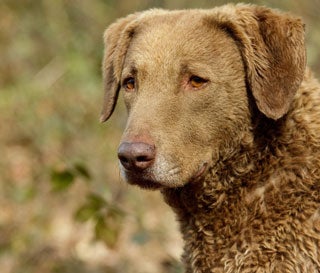Learn about dog breeds
Detailed information & photos on over 190 different breeds
Description
From the time the Chesapeake Bay Retriever is born, it is easy to view the extreme sturdiness of the little puppy, demonstrating the muscular power that will be present as they grow into adults. They are Known for breaking ice when duck hunting, diving off a boat, or even a ship is no problem for this power-pack.
A broad and strong round head is offset by a gentle looking tapered-muzzle, which helps develop a softer-looking profile as compared to many other retriever breeds. Its eyes are amber-color to a yellowish hue, which really makes them stand out against the dark-colored Chessies. The basic description of this breed is a robust build, with ears that are folded instead of up which are smaller than most retrievers.
Coat Description
The Chessie has slightly irregular coat lengths that give it protection from the short-hair on its face and head, to the longer and wavier hair on its total body area. Originally developed as a water retriever, this breed's double-coat has a tendency to feel oily-skinned on both layers, allowing it to pretty much be dry when it comes out of the water. Used as a water repellent, both coats can withstand extreme weather and water temperatures with the majority of the water sliding off the body of the oily hair of the dog.
A range of light brown colors--such as a light-tannish or even called straw-color--clear down to a deep brownish color or mahogany-brown are traditional colors for this breed. A short and wavy dense coat runs down the center-of-its back while also going down the neck-and-shoulder areas.
History
A fascinating history, the Chesapeake Bay Retriever was found to begin with a pair of Newfoundland puppies that were on a wrecked ship, off the Eastern coast of the United States. Actual documentation still exists today of the accident, written in the year 1845 by George Law, who worked for the ship that wrecked.
The surviving homeless puppies became adopted, eventually becoming bred to the area's recognized retrievers and their local dogs, which led to the Chesapeake Bay Retriever. Over the years, the Chessie developed into a very sturdy breed that could withstand the local weather and water temperature.
It is thought these local dogs were the Irish Water Spaniel and local hounds, eventually developing the background of this popular retriever.
Temperament
This breed has been known to be a family dog of the best qualities, in addition to getting along with pets and children of the family. A dog that is always eager to learn new things, but it can become quite aggressive toward other dogs as it grows up, often maturing with territorial attitudes.
Part of this is directed toward their watchdog abilities, which can become an issue if not controlled. Most hunting dogs are not excessively independent or stubborn, maintaining”selective hearing" ability toward their owners or trainers. But in reality, they simply want to be reward or praised for a job well done, or understand why a command is given.
Health Problems
Many people feel this breed of dog has very few issues, but there are certain areas that can be considered as "weak points" for them with the main testing areas are eyes and hips. The hip area, where CHD, or canine hip dysplasia, is the main problem area--in fact, in large dogs this can be a very big issue.
Another health issue is gastric torsion "bloat", where too much food is eaten all at once and then overly exercising them immediately afterward. Other than that, the minor concerns are few and far between with this breed, such as PRA and the occasionally seen entropion.
PRA, or Progressive Retinal Atrophy, is something that has been documented with this breed and concerns the eyes. Symptoms begin with night blindness and progress to total blindness for them. DNA testing can be done to check this out, or a retinoscopic exam.
Elbow dysplasia and cerebella abiotrophy are minor concerns that can be seen in some dogs.
Grooming
Due to its short hair and frequent dips in the water, this is considered an easy to maintain breed. About as hard as it gets are the brushings to remove dead hair and anything else in the way of the short-wire-brush or pin-brush.
Baths are not usually part of this dog's grooming as they are water dogs anyway, with coat that is water repellant. Too much water or bathing will cause its coat to dry out. No grooming of clipping or cutting is required, as their coat is short.
Exercise
Keeping mentally focused is an important main goal for the robust Chessie, requiring long and routine exercises to keep their minds steady, such as their love of life--swimming or any water sports. If this cannot be accomplished, they are known to have a destructive personality and basically "fall apart."
Considered to be a born-again retriever, this breed cannot jump and land on its legs a lot due to the CHD issues it has. Low-ground games of fetch as compared to jumping in the air to catch something above its head is recommended highly.
Training
Training at a very young age is almost mandatory for the Chespeake Bay Retriever, in order to avoid negative-behaviors and remove its tendency for stubborn independence.
Some trainers feel this breed is not as quick to learn as other breeds, but on a one to four, they still place a high three, provided their trainer is patient and uses repetition of the commands. It is also very much advised to use only one trainer for the basic training, instead a series of them. Once the basic commands are learned, the dog can be transferred to another trainer for another type of training, or the owner can begin to use the more advanced level of training.
Advertise | Privacy Policy | Terms of Use | Contact Us © Copyright 2004-2024 PupCity.com. All rights reserved.
